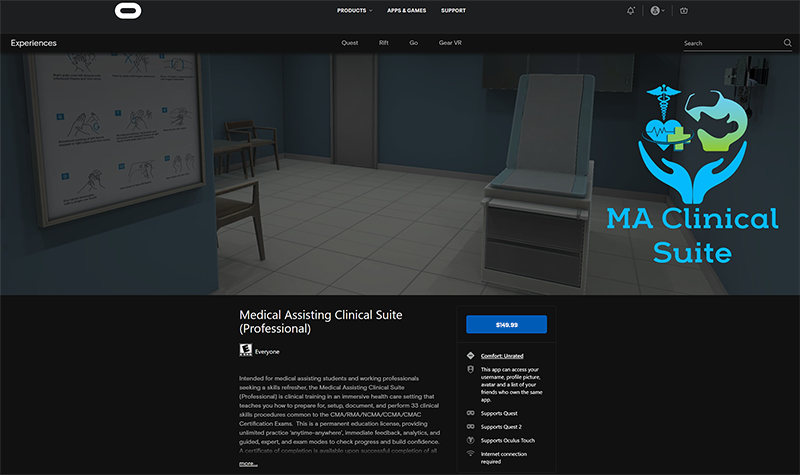A medical assistant may be responsible for performing diagnostic tests. Among the most essential of these is Electrocardiogram (ECG or EKG) testing, which gives doctors critical information about the function of the heart.
This procedure includes preparing for, performing a 12-lead ECG (EKG) test, and interpreting the heart rate and rhythm for common pathologies. The medical assistant must also be able to recognize heart rhythms which may indicate cardiac problems requiring immediate intervention by the doctor.
Learning Sequence Builds Confidence
The learner practices the procedure in the ‘guided mode’ (interaction hints and an expanded checklist guide) as often as they like.
When the learner is confident that they can accurately demonstrate the procedure without error, the learner plays the level in the ‘expert mode’ (no hints or checklist explanations) - which they can repeat as often as they wish.
Finally, when the learner is confident that they have mastered the procedure - they take a one-time ‘exam’ attempt which results in their grade for that procedure.
The Medical Assisting Clinical Suite (Professional) Edition is available for purchase through the Oculus AppLab for $149.99
Features
Guided Mode - ghosted hints show step-by-step positions, learner can 'see through' the patient to verify placement.
Oculus Quest Affordability & Ease of Use - next generation game development processes allow the untethered, mobile VR to present effective visual and interaction fidelity at 1/4 of the cost of desktop VR.
Feedback - Cloud-based enterprise incorporates real-time data acquisition that allows learner to track progress and mastery, and provides detailed insights for debrief with faculty.
Support - Enterprise incorporates Knowledge Base (with tutorial videos & FAQ) - combined with help desk support staff for learners and staff.
Sterilize Equipment Checklist
- Gather supplies.
- Setup tray with equipment.
- Assemble alligator clips on lead wires.
- Load ECG machine with ECG paper.
- Review the physician’s test order / patient EMR.
- Perform handwashing.
- Call the patient to the treatment room, Introduce yourself, ask them to identify themselves with their full name and date of birth.
- Explain the procedure and obtain verbal consent, allow patient time to ask questions.
- Ask patient to put on gown, remove socks or jewelry, turn off electronic devices including phones.
- Position patient in a comfortable semi-recumbent position on exam bed using pillows.
- Give patient rest time before starting procedure.
- Discretely expose patient’s chest and extremities.
- Clean the sites where the electrodes will be placed by cleansing the skin with alcohol wipes.
- Apply the self adhesive electrodes to the extremities:
Apply electrodes above each wrist.
Apply electrodes above each ankle.
Apply the self adhesive electrodes to the chest:
Place the V1 electrode in 4th intercostal space at the right sternal border.
Place the V2 electrode in 4th intercostal space at the left sternal border.
Place the V4 electrode in 5th intercostal space in the mid clavicular line.
Place the V3 electrode midway between the V2 and V4 electrode sites.
Place the V5 electrode in the anterior axillary line at the same horizontal level as the V4 electrode.
Place the V6 electrode in the mid axillary line at the same horizontal level as the V4 electrode. - Attach the lead alligator clips to the electrodes on the extremities (Ride Your Green Bike)
Red - right upper limb
Yellow - left upper limb
Green - left lower limb
Black - right lower limb - Attach lead alligator clips to the chest electrodes.
- Turn on machine.
- Calibrate to 10mm/mV Rate at 25mm/s.
- Enter the patient’s name and DoB into the ECG machine.
- Disconnect alligator clips from electrodes.
- Remove electrodes and discard them in the hazard bin.
- Ask the patient to get dressed. And advise them that the physician will interpret and discuss the ECG results with them.
- Remove and discard gloves, and perform hand hygiene.
- Document the procedure and findings according to agency policy.

